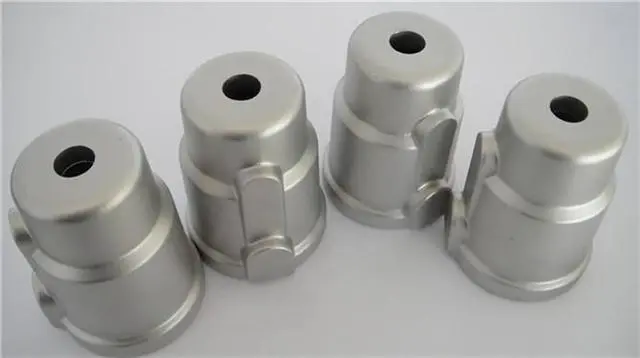This article provides an overview of surface treatment processes for various metals, including stainless steel, aluminum alloy, magnesium alloy, zinc alloy, and more. Here’s a closer look at each metal type and the treatment options available:
- Stainless Steel: Electroplating, polishing, brushing, electrophoresis, PVD (Physical Vapor Deposition), etching, colored passivation
- Aluminum Alloy: Anodizing, electroplating, etching
- Magnesium Alloy: Electroplating, passivation film
- Titanium Alloy: Electroplating, anodizing
- Zinc Alloy: Electroplating, passivation
- Cast Aluminum: Electroplating, anodizing
- Steel: Passivation, phosphating
Below are descriptions of several common surface treatment processes:
1. Anodizing
Anodizing is an electrochemical process that forms a protective oxide layer on the surface of aluminum and its alloys. During this process, aluminum serves as the anode and is immersed in an electrolyte solution, generating an alumina (Al₂O₃) film through electrolysis. This oxide layer can range from a few microns to hundreds of microns in thickness, offering enhanced corrosion resistance, wear resistance, and decorative appeal compared to natural oxide films.
Process Flow:
- Single Color, Gradient Color: Polishing/sandblasting/brushing → Degreasing → Anodizing → Neutralizing → Dyeing → Sealing → Drying
- Two Colors:
- Option 1: Polishing/sandblasting/brushing → Degreasing → Masking → Anodizing 1 → Anodizing 2 → Sealing → Drying
- Option 2: Polishing/sandblasting/brushing → Degreasing → Anodizing 1 → Laser Engraving → Anodizing 2 → Sealing → Drying
Notes: Two-tone anodizing requires higher costs due to the need for masking and double anodizing, resulting in a higher defect rate.
2. Electrophoresis
Electrophoresis is commonly used for materials like stainless steel and aluminum alloy, adding color while preserving a metallic shine and enhancing surface protection, particularly against corrosion.
Process Flow: Pre-treatment → Electrophoresis → Drying
Advantages:
- Wide range of color options
- Retains metallic sheen, suitable for combining with sandblasting, polishing, or brushing
- Allows surface treatment of complex structures in a liquid environment
- Mature and efficient process, ideal for mass production
3. Electroplating
Electroplating involves depositing a thin metal layer on a product’s surface through electrolysis, providing corrosion resistance, improved wear resistance, better conductivity, increased reflectivity, and a decorative finish.
Process Flow: Pre-treatment → Cyanide-free alkaline copper → Cyanide-free white bronze-tin → Metal coating
4. Powder Coating
Powder coating uses electrostatic spray equipment to apply powdered paint to the workpiece. Under electrostatic attraction, the powder adheres uniformly to the surface, forming a coating that is cured under high heat to produce a smooth, durable finish.
Process Flow: Loading → Electrostatic dust removal → Spraying → Low-temperature leveling → Baking
Differences Among Processes
- Masking Capabilities: Electroplating, electrophoresis, and anodizing do not allow easy masking, while powder coating and painting can.
- Re-processability: Once formed, electrophoresis and anodizing create an insulating layer that cannot be reprocessed, while powder coating, painting, and electroplating can undergo multiple treatments.
- Material Suitability: Anodizing is suited for magnesium, aluminum, and their alloys. Electrophoresis works on any conductive surface, while electroplating, powder coating, and painting are compatible with almost all metals.
- Corrosion Resistance: Corrosion resistance depends on the coating’s quality, with electrophoresis generally offering superior protection.
Advantages and Disadvantages of Key Processes
- Electrophoresis
- Advantages: Environmentally friendly, water-based coatings; high paint utilization (85%); excellent corrosion resistance; efficient for large volumes; low coating cost per unit area.
- Disadvantages: Limited color options that are harder to modify; high initial setup cost; only suitable for conductive materials; requires high-temperature curing.
- Electroplating
- Advantages: Produces a metallic luster; high hardness; no heat required for curing.
- Disadvantages: Potential heavy metal pollution; limited color options; relatively high cost.
- Anodizing
- Advantages: Simple process; vibrant colors achievable; low cost.
- Disadvantages: Limited to magnesium-aluminum products.
- Powder Coating
- Advantages: Eco-friendly coatings; high material utilization; customizable colors.
- Disadvantages: Thicker film; requires high-temperature curing.
- Painting
- Advantages: Extensive color and coating options; numerous functional coatings available.
- Disadvantages: Low material utilization; less environmentally friendly; fire risk; requires a dust-free environment.
Thank you for reading. We are looking forward to serving you with our exceptional gear solutions. #BeyondGears
Read More:


